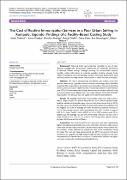| dc.contributor.author | Kiiza, Daniel | |
| dc.contributor.author | Kisakye, A. | |
| dc.contributor.author | Chebrot, I. | |
| dc.contributor.author | Kwesiga, B | |
| dc.contributor.author | Okello, D. | |
| dc.contributor.author | Kabwongera, E. | |
| dc.contributor.author | Basaza, R. | |
| dc.date.accessioned | 2018-12-18T10:25:00Z | |
| dc.date.available | 2018-12-18T10:25:00Z | |
| dc.date.issued | 2018 | |
| dc.identifier.uri | http://hdl.handle.net/20.500.12280/1262 | |
| dc.description.abstract | Reducing infant and under-five mortality by use of costeffectivestrategies like immunization continues to be a challenge, particularly in resource limited settings. Strategic planning for immunization requires credible costing information to estimate available funding, allocate funds within the program and avoid funding shortfalls. This study assessed the total and unit costs of providing routine immunization in health facilities in Kampala. This was a retrospective descriptive cost analysis study that applied a bottom-up, ingredients-based costing methodology which identified costs from the perspective of the health service providers. The cost of providing
immunization services in health facilities in Kawempe Division in the financial year 2015/2016 was determined using relevant data which was collected using an Excel questionnaire adapted from the CostIt software of the World Health Organization. The analysis was also based on the same CostIt software.
The average total facility immunization costs were USD 14,415.1 with a range of 8,205.3 at private for profit to USD 47,094.9 at public health facilities. Vaccines and supplies were the main cost driver accounting for 63.6%
followed by personnel costs at 24.0%. Routine facility based immunization had the highest cost with an average of 47.9% followed by outreach services at 32.3%. The average cost per dose administered was USD 1.4 with a range of USD 1.0 in larger health centres (HCIV) to 1.5 in HCIII (medium-sized HC or dispensary). The average cost per DPT3 immunized child was USD 20.0 with arrange of USD 12.6 in HCIV to 22.0 in HCIII. The findings show a great variance between facility ownership and levels.
The study found that the recurrent costs were significantlyhigher than capital costs and this was across all facilities. Vaccines and personnel costs were the two main cost drivers. Routine facility based immunization was the costliest activity followed by outreaches with social mobilization being the least. The cost per dose administered and DPT3 immunized child were dependent on outputs with high output health facilities having less unit costs compared to facilities with less out outputs. Private health facilities had higherunit costs compared to publicly owned health facility | en_US |
| dc.language.iso | en | en_US |
| dc.rights | Attribution-NonCommercial-NoDerivs 3.0 United States | * |
| dc.rights.uri | http://creativecommons.org/licenses/by-nc-nd/3.0/us/ | * |
| dc.subject | Routine immunization services | en_US |
| dc.subject | Poor urban setting | en_US |
| dc.subject | Kampala, Uganda | en_US |
| dc.title | The Cost of Routine Immunization Services in a Poor Urban Setting in Kampala, Uganda: Findings of a Facility-Based Costing Study | en_US |
| dc.type | Article | en_US |



